|
World War II had only been
over three years when the U.S. Navy began jet fighter operations from aircraft carriers.
Angled decks had not even entered service when the
North American
FJ-1 Fury jet fighters made the first takeoffs and landing on the straight−deck
USS Boxer.
The USS Forrestal, our
first angled deck carrier, was commissioned in 1951. This story appeared in a 1948
issue of Popular Science magazine. Note the huge clock on deck which was
photographed upon being triggered by the airplane hooking an arrestor line, so that
a precise lending time would be recorded. The way the picture is taken, it looks
like a perspective trick to make a small clock look much larger than it actually
was. I like the fact that Lt. Comdr. Robert Elder took a wave−off on a first approach
in order to give his skipper, Comdr. Evan (Pete) Aurand the honor of the first−ever
jet aircraft landing at sea. Nowadays, computers routinely fly jet−powered drones
off of and onto carrier decks.
How New Jets Hit the Deck for U. S. Navy
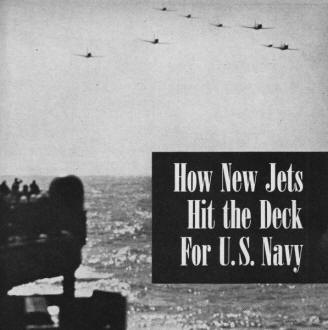
Eight Furies salute the aircraft carrier Boxer during the U.
S. Navy's jet-launching operation.
By Andrew R. Boone
Successful landings and launchings on a carrier at sea initiate jets as a part
of our ocean-borne air force.
Flashing down over the fantail of the U. S. aircraft carrier Boxer one sunny
day last March, a thick-bodied, thin-winged fighter hit the deck and slid to a stop
in the grip of the arresting gear. A routine landing in all but one respect: the
plane.
It was a shining new North American Fury - the first all-jet fighter ever to
land on a carrier's deck under operational conditions at sea. Its arrival aboard
the big Essex-class carrier off the California coast meant that years of Navy research
and experiment had finally paid off in a new era of 10-mile-a-minute fighter sweeps
for the fleet's air arm.
The historic landing was made by Comdr. Evan (Pete) Aurand, skipper of Fighting
Squadron Five Able. Forty seconds later, Fighting Five's executive officer, Lt.
Comdr. Robert Elder, followed Aurand in, setting his Fury down as soon as a squat
deck tractor had tugged the lead plane beyond the crash barriers. For practical
reasons, only these two of the squadron's planes landed in the initial test. But
to make the trial complete, they took off under their own power and landed again,
then took off a second time with the help of the catapult.
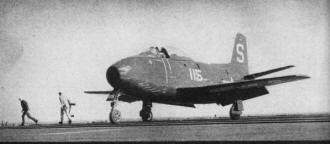
Crewmen scurry away as the Fury, with Aurand
at the controls, prepares for the first operational launching of a jet plane from
a carrier deck. Six .50-cal. machine guns are mounted in the thin wings. With wing-tip
tanks carrying an extra 300 gallons of kerosene added to 500 in fuselage tanks,
the jet fighters will be able to stay aloft four hours and cover 1,500 miles.
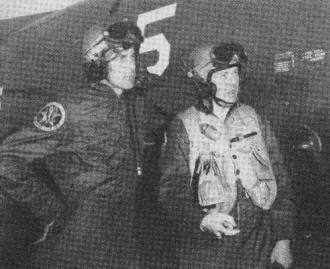
Fighting Squadron Five's executive officer Elder
(left) and Commander Aurand, who made historic jet-fighter landings on a carrier.
Operation took place off the coast of California.
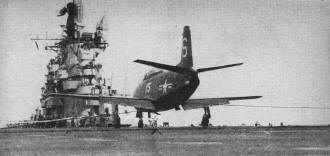
A dramatic moment in aviation history: Aurand's
Fury becomes the first jet plane to make an operational landing on a carrier at
sea. Note the first thwartship arresting wire bringing the 11,000-lb. fighter, moving
at 115 m.p.h., to a dead stop after a roll of only 50 feet along the Boxer's deck.
Meanwhile a destroyer waits astern, just in case the Fury "hits the drink."
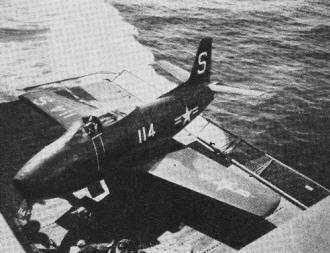
Towed to aft elevator, plane shown above is
lowered to hangar below deck. After refueling and servicing, it will be moved to
forward elevator and raised to flight deck for catapulting.
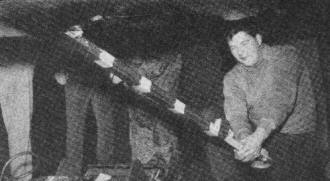
Mechanic works to free landing hook. After each
landing during the trials, the planes were thoroughly inspected and completely serviced.
These jobs were done in a hangar below deck.
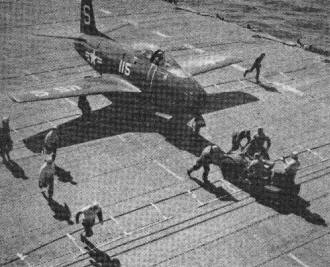
Immediately after the first landing, a small
tractor pulls Aurand's plane up the deck beyond the crash barriers. Within half
a minute, Elder sat his Fury down at the same spot.
These and succeeding trial runs, which followed 200 landings on a make-believe
carrier deck marked out on a California airfield, illustrated many of the factors
that make seagoing jet operations a different business from propeller-powered flight.
As a striking force, a big carrier transports about 100 planes. Conventional
fighters, taking off under their own power, can be launched every 15 seconds or
so. Catapulting gets them off about a third as fast. In repeated tests, the Furies
have shown that they can get aloft almost as quickly as propellered planes when
deck-running, and about as fast when catapulted.
Jets don't accelerate rapidly at low speeds, so they need a longer run-the full
length of the flight deck. Also, the roaring exhaust blasting back along the deck
complicates the launching of several planes at a time, since it requires greater
headway. Headway, which here means the distance (or time) between objects following
one another along the same path, is a measure of effectiveness. It corresponds to
the rate of fire of a machine gun.
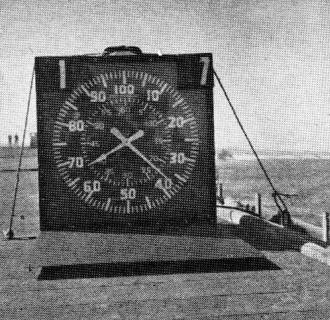
Landing speed of each plane is photographically
recorded as it hits the wire. A camera mounted at edge of deck catches both plane
and the split-second clock face shown above.
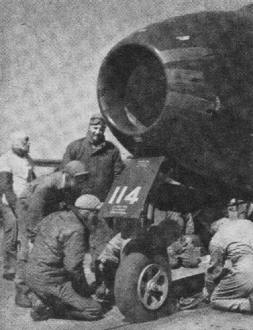
Nose-wheel gear of Elder's plane is being checked
by crewmen immediately after landing. Elder took a wave-off on an earlier approach
to give his skipper the honor of the first landing.
Jets have one tremendous advantage over reciprocating engines: they need no warm-up.
At any alarm, a jet can be moved from a deckload of parked planes, started, and
launched at once. The Boxer's Furies were clocked aloft less than two minutes after
their engines were turned on.
All this means that a special system of catapulting will probably be evolved
to shoot jets off, perhaps with a moving-chain pickup delivering them to the catapult
stations. Two catapults, one on each side of the flight deck, could get a squadron
of 18 planes into the air in six to eight minutes.
Jato rocket units could be used, but experienced pilots don't expect it. Jato
drenches the deck with smoke. Sometimes rockets fail, ruling them out as an absolutely
reliable launching aid. If generally used, large numbers of the Jato units would
have to be stored aboard a carrier in space that is already precious.
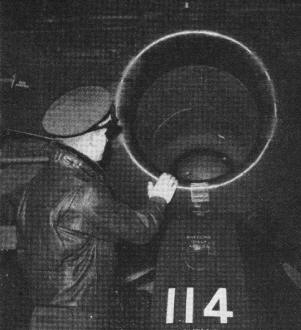
The Fury gulps 72 cubic feet of air a second
through this great gullet. Unlike that on some other jets, the intake is not split.
The duct runs in a straight line from the nose to the tail.
The jet pilots prefer the catapult, modern versions of which provide a relatively
smooth start. A jet plane zooms from zero to nearly 150 m.p.h. in a run of only
93 feet on the "cat," but acceleration is no more than 2.5 G - "less," as Aurand
points out, "than we suffer in a tight turn."
Jet landings present new factors, too. Coining home to roost, the pilots fly
a different approach pattern. In a Fury, with no big radial engine up front to obstruct
his vision, a pilot can see exactly where he's going. For the first time, he can
see the crash barriers raised amidships on the flight deck to stop his plane if
it bounces over the 12 arresting cables, stretched across the deck at 25-foot intervals.
"Actually," Aurand told a Popular Science reporter, "it's a little frightening
to watch those barriers come up." But both he and Elder agreed that landing a jet
on a carrier was easier than setting down a conventional fighter.
For all the differences in jet landings and take-offs, most of the major problems
concerning jet fighters have been solved. On the basis of the Boxer tests, the Navy
feels that only practical details remain to be worked out, and a broad expansion
of the jet program is already under way.
Fighting Five will be fully operational this summer. On the East Coast, Fighting
Squadron Seventeen is getting set for sea duty with McDonnell FH-1 Phantoms. These
squadrons will provide a nucleus of trained pilots and crewmen for other groups.
Both Furies and Phantoms are considered interim models (their successors may
be the faster and longer-range McDonnell F2H Banshee and the Grumman F9F Panther),
but they provide examples of what jet propulsion means to the U. S. Fleet. The Fury,
for instance, has a top speed of more than" 550 m.p.h., and climbs to its fighting
altitude faster than a mile a minute. At cruising speed, it can cover 1,500 miles
during a four-hour flight; at top speed, it can stay aloft a few minutes short of
an hour.
Fine for fighters, jet propulsion has one well-known limitation: it is least
efficient at low altitude. And since many attack missions are flown "just off the
deck," it is not yet practicable to use all-jet attack bombers. Therefore the Navy
is limiting its initial jet program to fighters.
But the more versatile turboprop attack types may join the jet fighters, and
eventually even the jets may be adapted to low-level operation. When that happens,
the Navy's air arm can really cash in on the program begun by Fighting Five.
Posted March 16, 2024
|